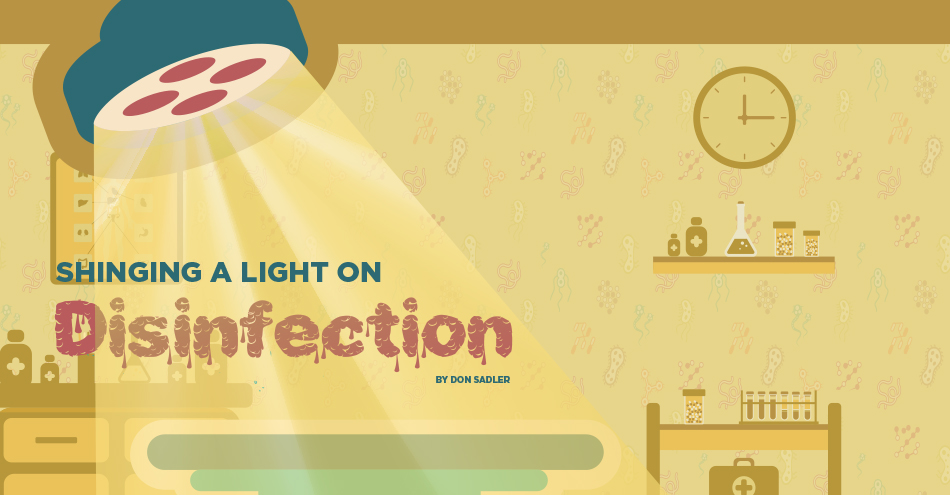Despite progress in recent years in the area of infection prevention, hospital-acquired infections (HAIs) still claim the lives of thousands of patients each year. An estimated one in every 25 hospitalized patients has at least one HAI on any given day, according to the Centers for Disease Control and Prevention
Thorough terminal cleaning and cleaning of ORs between cases remains the most effective ways to reduce HAIs. The good news is that a number of new disinfection techniques and technologies have been developed to help combat HAIs.
 Common Causes of HAIs
Common Causes of HAIs
“There are many types of HAIs, but among the most common are those associated with indwelling devices used in medical procedures,” says Laurie Rabens, senior product manager, Clorox Healthcare. “These include central line-associated bloodstream infections (CLABSIs), catheter-associated urinary tract infections (CAUTIs), and ventilator-associated pneumonia (VAP).”
Rabens points to a 2014 multistate point-prevalence survey of HAIs, as reported to the National Healthcare Safety Network (NHSN), that found that Clostridium difficile (C.diff) was the most common cause of HAIs, followed closely by Staphylococcus aureus (MRSA).
“Many surfaces in the OR are contaminated with organisms that cause infections,” says Sam Trapani, the president and CEO of Steriliz, a supplier of ultraviolet-C light disinfection technology. “Sometimes, these surfaces are not sufficiently cleaned, either between cases or terminally at the end of the day. When someone makes contact with the surfaces, they become a vector and transmit the pathogen to the patient.”
 According to Rabens, establishing and maintaining thorough daily cleaning (both between cases and terminally) and disinfecting procedures is a cornerstone of any effective infection control program for surgical settings.
According to Rabens, establishing and maintaining thorough daily cleaning (both between cases and terminally) and disinfecting procedures is a cornerstone of any effective infection control program for surgical settings.
ECRI Institute’s 2017 Top 10 Hospital C-Suite Watch List report notes that some hospitals have adopted environmental disinfection systems that use ultraviolet-C (UV-C) light or hydrogen peroxide vapor (HPV) to complement existing infection control protocols.
“UV light has been increasingly used as an effective method to kill microorganisms,” says the ECRI Institute report.
According to Trapani, studies have shown that manual cleaning using bleach or other liquid disinfectants achieves only a 30 to 50 percent disinfection of contaminated surfaces.
“This is why it’s necessary to implement advanced disinfection technologies that measure the delivered UV-C dose to kill pathogens,” he says.
 “We stand by terminal cleaning and cleaning between cases – these are normal protocol in any OR,” says Kerry Riek, a senior associate in ECRI Institute’s Applied Solutions Group. “This includes manual cleaning with bleach and other liquid disinfectants. Devices using UV light, like disinfection robots, and visible LED ceiling fixtures can be used as supplements to manual cleaning.”
“We stand by terminal cleaning and cleaning between cases – these are normal protocol in any OR,” says Kerry Riek, a senior associate in ECRI Institute’s Applied Solutions Group. “This includes manual cleaning with bleach and other liquid disinfectants. Devices using UV light, like disinfection robots, and visible LED ceiling fixtures can be used as supplements to manual cleaning.”
Amber Wood, MSN, RN, CNOR, CIC, FAPIC, senior perioperative practice specialist, the Association of periOperative Registered Nurses (AORN), concurs.
“Room decontamination technologies as an adjunct to manual cleaning may be useful tools to help prevent infection by enhancing environmental cleanliness,” says Wood.
“There is no replacement for manual cleaning and disinfection of surfaces,” adds Wood. “If contaminates are not removed from a surface, the surface cannot be disinfected. Therefore, emerging technology for room decontamination should only be used as an adjunct to manual environmental cleaning procedures.”
How UV Disinfection Technology Works
Dr. Mark Povroznik, vice president, quality/CQO at United Hospital Center in Bridgeport, West Virginia, has spoken frequently about the use of UV light in hospital disinfection. He explains that there are three basic forms of UV light: UV-A, UV-B and UV-C.
“UV-C has proven effective as a no-touch germicidal,” says Povroznik. “It can be recreated via the use of two light sources: mercury and xenon. At United Hospital Center, we’ve utilized both types of UV devices.”
In simple terms, pulsed xenon UV destroys pathogens in a different way than mercury UV, says Povroznik. “And it does so much faster,” he adds.
 In 2010, United Hospital Center opened a new state-of-the-art hospital that deployed mercury UV devices as part of its strategy to control environmental bio-burden. Then in February of this year, it modified from mercury-based UV to pulsed xenon UV.
In 2010, United Hospital Center opened a new state-of-the-art hospital that deployed mercury UV devices as part of its strategy to control environmental bio-burden. Then in February of this year, it modified from mercury-based UV to pulsed xenon UV.
“We have 11 ORs that are disinfected nightly,” says Povroznik. “Because of the size of the ORs, we run the LightStrike xenon UV robot for 10 minutes in two different positions after the room has been terminally cleaned.”
Povroznik stresses that it’s important to run the UV disinfection device in multiple positions to ensure that all surfaces are properly disinfected.
“In addition, our robots are deployed in special procedure areas and sterile mixing in the pharmacy,” he says.
Hospital-wide infection rates have remained low at UHC and the targeted units have seen a modest reduction in a relatively short period of time, says Povroznik.
“For matched time periods, HAIs have been further reduced by 27 percent,” he says.
No Silver Bullet
Rabens stresses that UV disinfecting technologies are not a silver bullet that can be used alone to decontaminate hospital rooms.
“It’s important to remember that these technologies are designed to supplement, not replace, manual surface cleaning and disinfection with EPA-registered disinfectants,” she says.
“Manual disinfection is still essential for removing soils and killing pathogens on environmental surface,” Rabens adds.
Rabens recommends using UV devices after manual disinfection to reach areas of the OR that may otherwise be missed or insufficiently addressed due to human error.
“Also, the presence of organic matter, such as dried blood, can shield pathogens from the UV light and reduce the treatment’s effectiveness,” she adds.
When selecting a surface disinfecting product, Rabens says it’s important to consider a few key factors such as relevant pathogen kill claims, wet-contact times (or how long the product needs to stay wet on the surface in order to kill the pathogens), ease-of-use and safety.
“Sodium hypochlorite, the active ingredient in bleach, is one of the few actives that is effective at killing C. difficile spores on environmental surfaces,” says Rabens. “It is cited by more clinical studies to kill C. difficile than any other active ingredient.”
Rabens adds that Clorox Healthcare bleach germicidal disinfectants are designed to be fast-acting and kill a broad range of pathogens. These include C. difficile spores as well as emerging and reemerging pathogens like MERS-CoV, SARS-CoV, Enterovirus D68 and the Measles virus. Clorox offers a UV-C device in its Optimu-UV Enlight System.
Battling Misconceptions
Povroznik says there are some common misconceptions when it comes to the use of UV disinfecting technologies in hospitals. One of them is how much additional time using these technologies will take.
“While UV disinfection does add time, this can be managed by sequencing the cleaning and deployment of the robots based on room design,” he says.
Another misconception involves single room placement of UV disinfecting devices versus multiple sites in the room.
“Studies have proven that while UV light can reflect off of surfaces, it does not do so in high enough intensity to be equally germicidal over distances,” says Povroznik.
The optimal way to use UV-C light in an operating room is to disinfect with multiple positions in the room and to account for equipment and overall room size, Povroznik adds.
Evaluating the Technology
Wood believes that further research is needed to determine the applicability of UV disinfecting technologies in the perioperative setting.
“In the operating room, these technologies should be evaluated for their efficacy, safety for personnel, compatibility with equipment, impact on environmental controls, time per cycle and cost,” says Wood. “Some systems may be practical for use between procedures while others may be better suited for use at terminal cleaning.”









